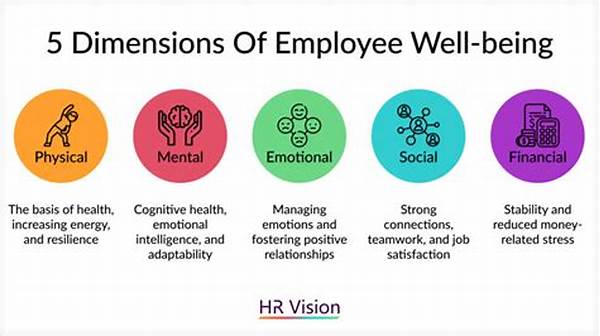Hey there, friends! Today’s topic is improving employee health and well-being—something that’s becoming a hot topic in workplaces everywhere. With tighter schedules and endless to-do lists, sometimes we forget that our health is just as important as meeting deadlines. But guess what? A healthier employee is generally a happier, more productive one. So, let’s dive into some awesome ways to make work a more health-friendly zone!
Read Now : Beach Resorts With Kids Clubs
The Importance of Employee Well-Being
When it comes to improving employee health and well-being, companies are waking up to the reality that it’s more than just offering gym memberships. Your well-being reflects on everything—from productivity to the office atmosphere. If you’re dragging yourself out of bed every morning dreading the day ahead, maybe it’s a sign your workplace wellness needs a boost.
Incorporating wellness programs can be a game-changer. These programs don’t have to be complicated or expensive. Simple things like standing desks, meditation rooms, or even offering free fruits in the lounge area can make a huge difference. These little tweaks help create an environment where employees actually love showing up each day.
Remember, a healthy employee is an engaged employee. The more companies invest in improving employee health and well-being, the more they’ll see positive returns not only in employee satisfaction but also in creativity and innovation. A win-win situation, if you ask me!
Practical Steps to Enhance Workplace Wellness
1. Flexible Work Schedules: Give employees more control over their work hours. This approach can significantly lower stress levels, improving employee health and well-being.
2. On-Site Fitness Facilities: Having a gym at work nullifies any excuse to skip workouts, plus it encourages social bonding and team spirit.
3. Mental Health Days: Offering mental health days shows you value the emotional and mental well-being of your team, not just their productivity.
4. Health Workshops: Host workshops focusing on nutrition, mental health, and fitness. These sessions can be enlightening and significantly contribute to improving employee health and well-being.
5. Ergonomic Office Design: A workspace that’s physically comfortable can prevent injuries and promote better posture, contributing to long-term health.
Creating a Culture of Well-Being
The goal of improving employee health and well-being should be a collective effort within any organization. When employees see that management cares about their health, they’re more likely to be committed, productive, and happy. But how do you instill such a culture?
First off, open lines of communication. Encourage feedback and suggestions on how to make the workplace more conducive to healthy living. Sometimes the best ideas come straight from those who would benefit from them most. Create an atmosphere where employees feel safe to express their needs and concerns regarding their health.
Secondly, champion well-being initiatives from the top down. If team leaders and managers are setting the example by actively participating in wellness programs, employees are more likely to follow suit. By promoting a holistic approach to well-being that includes physical health, mental health, and social connections, you create a balanced work environment that draws out the best in everyone.
The Role of Leadership in Promoting Health
It’s no secret that when it comes to improving employee health and well-being, leadership plays a significant role. Leaders who prioritize and model well-being behaviors can inspire their teams to do the same. It’s about setting an example and being proactive.
1. Lead by Example: Leaders should embrace well-being practices themselves. Whether it’s prioritizing work-life balance or attending health workshops, their actions speak louder than words.
Read Now : Best Honeymoon Resorts Bali Deals
2. Encourage Open Dialogue: A transparent approach helps eradicate any stigmas surrounding health issues. Employees appreciate when they feel heard and understood, fostering trust.
3. Recognize Efforts: Celebrate the milestones and achievements of employees who engage in wellness programs. Recognition can be a strong motivator for others to start their wellness journeys.
4. Offer Resources: Provide easy access to both physical and mental health resources, showing a commitment to improving employee health and well-being.
5. Continually Assess and Improve: Leaders must consistently evaluate the effectiveness of well-being programs and seek new areas for improvement, ensuring the initiatives remain impactful.
Creating Emotional Well-Being at Work
The work environment can significantly impact emotional health, so focusing on emotional well-being is crucial to improving employee health and well-being. For starters, promote positive interactions among employees—encourage social gatherings both inside and outside of work. Strong workplace relationships lead to better team dynamics and enhanced support systems.
Also, consider providing access to professional counseling services. Whether it’s through an Employee Assistance Program or onsite consultations, having an outlet to discuss personal issues can be invaluable. Remember, a balanced employee is a more productive employee!
Sustainable Approaches to Workplace Health
Improving employee health and well-being calls for sustainable methods that aren’t just short-lived trends. Think of long-term solutions that can easily adapt to the ever-changing work landscape. This could be a flexible wellness budget for employees to use as they see fit, perhaps for a fitness class or a mindfulness app subscription.
Regular check-ins with employees on how the programs are benefiting them can also provide invaluable insights for continual refinement and effectiveness. Everyone’s needs are different, and flexibility is key to a thriving wellness initiative. The main goal is to make health and well-being a seamless part of everyday work life, not a separate checkbox task.
Final Thoughts on Improving Employee Health and Well-Being
At the end of the day, improving employee health and well-being is a community effort—it takes the involvement and enthusiasm of the entire company. While the path to full implementation might seem daunting, starting with small, meaningful changes can gradually lead to significant improvements.
Incorporating wellness into the company culture isn’t only about increasing productivity rates; it’s about caring for the most valuable asset any company has—its people. By fostering a supportive and health-conscious environment, you’re not just improving the lives of your employees but also crafting a legacy of well-being and happiness.
Ultimately, concentrating on improving employee health and well-being contributes to building a thriving, energetic, and innovation-driven workplace. A place where everyone feels valued and motivated to give their best. Remember, the journey of a thousand miles begins with a single step. So why not take that step today?



